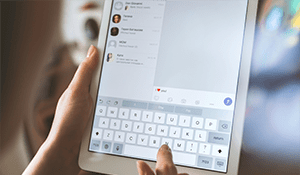When it comes to consumers, their behaviors, emotions, and influences change but the one thing we know for sure is: people do business with people they like and trust; they value that “human touch”. Digital transformation is met with apprehension from a large portion of the consumer population, but we assure them that adopting this new technology will make their experience better, more accurate, more informed, more personal.
However, without a humanized, authentic approach, customers are left with cold, inflexible, and unnatural digital interactions and a customer experience that’s the exact opposite of what they want.
So, how can you leverage your digital interactions to build brand trust and loyalty? Keep reading.
Why It Matters
Before I can give you the how, I have to give you the why—so, why is a humanized digital experience important? Let’s use Amazon as an example.
When you make a purchase on Amazon, is there an authentic, human influence on your experience? Nope. Why not?
Because Amazon is one of the 44% of businesses who implement a digital-first approach and their mission for customer-centricity is focused on product need and availability, not personal connection. So, while their AI is intuitive and can provide insightful product recommendations, it doesn’t have that “human touch”. Understand, I’m not harshing on Amazon but I’m about to make a solid point so just follow me on this.
While a well-designed digital-first approach can still flourish and elicit likability, trust, and a great customer experience, by design it lacks the human touch that people naturally gravitate to. Adding a human element to the digital experience may not seem super important because Amazon’s doing just fine, but they’ve also done something no one else can: dominate the mindshare in online shopping.
They have the capacity to traffic more than a third of all retail products bought or sold online which requires an astronomical amount of time and resources. Frankly speaking, we can’t all be Amazon.
Furthermore, while their success is undisputed, Amazon hasn’t been immune to negative press and the effects of COVID-19. Their customer satisfaction has declined 9% in the last year, and 23% since 2015 (RBC Capital Markets). But as a result, Amazon responded with a national ad campaign that spotlights satisfied employees and their company culture.
In other words, when Amazon drifted from its customer-focused mission, they promoted the one thing that has the most positive influence on consumers: humans and authenticity. This proves that regardless of size, industry, offering, or level of success, customers connect with and are loyal to authenticity and human connection above all else.
Now that we understand why it’s important, let’s talk about how to do it.
1. Consider the needs of your customers first
While it’s tempting to minimize customers as happy vs. unhappy, satisfied vs. unsatisfied, there’s actually much more to it than that. A customer’s experience is built up of three main components—success, effort, and emotion.
- Success is the degree to which customers can accomplish their goals
- Effort is the ease or difficulty in accomplishing those goals
- Emotion is how the interaction makes the customer feel
To neglect or overlook any of these three factors will negatively impact your customer experience and consequently, your brand.
2. Be honest and upfront
Chatbots, AI, and digital assistants aren’t humans—I discuss this more in-depth in our ‘What is a Digital Agent’ post but simply put, they’re just narrative-based computer code that make decisions based on what we’ve taught them. To “humanize” these programs we must teach them to understand and speak our language, not just in terms of linguistics but also tone, sentiment, and intent.
Internally, it helps to think of a digital assistant like a brand new employee— AI is constantly learning and evolving, so if there’s a question it can’t answer it’s not because it isn’t working properly, it’s because it hasn’t been trained to know the answer. For this reason, it’s always important to be upfront with customers about your AI-powered employee.
Consider including an interaction to inform users about “best practices” so they understand how to use the resource effectively. For example, if a user asks a few questions the digital assistant doesn’t understand, it could trigger a response that says, “I’m sorry I’m having trouble understanding your questions. I’ll understand best if you ask short questions one at a time”.
Transparently communicating the way your digital technology functions and how to use it will set realistic expectations and elicit a more trusting and satisfied customer response.
3. Create natural responses
Design digital conversations that parallel natural interactions in daily life. For example, if your friend says, “tell me about your new car”, would you read them the spec sheet? Probably not.
Instead, you’d hit the high points, tell them why you decided to buy it, and if your friend wants to see the spec sheet, they’ll ask you for it.
The same goes for customers—if a customer asks a chatbot, “what material is this shirt made of?”. While it’s an accurate response, “100% ring-spun cotton” is cold, unnatural, and somewhat unhelpful. A better response would be, “This shirt is one of our best sellers! It’s made from 100% ring-spun cotton, and customers say it’s ‘soft and light with just the right amount of stretch’. What else would you like to know?”. This response feels more authentic and truly helps the user make an informed decision.
4. Make sure it does what you say it does
Digital assistants, chatbots and other AI-powered technology are all self-service tools that should be designed with one goal—to help users perform an action. There are two critical components of self-service tools: purpose and capability.
- Purpose is what the technology does
- Capability is how the technology accomplishes that purpose
For example, if a company offers a chatbot on their website for the purposes of customer support, but it’s only capable of answering questions from an FAQ knowledgebase, then it isn’t a customer support chatbot—it’s an interactive search tool. There’s two reasons this is important:
- To set the right customer expectation
Going back to our example, by framing the chatbot as a self-service support tool, customers will expect it to provide the same resolutions as your current customer support team. If it can’t do that then you can expect increased customer frustration and decreased satisfaction.
- To set the right customer expectation
- For authenticity and accuracy
It’s extremely difficult for users to navigate a conversation if it doesn’t give them all the information they need to make an informed decision. For example, if a user tells a chatbot, “I’d like a low interest loan”, an uninformed bot might respond, “Ok. For how much?”, leaving the user left to wonder if their query for low interest was understood. With real-time information gathered from secure APIs or third-party applications, the chatbot could provide a better response like, “I can help you with that! For loans above $500, we offer a low 7% interest rate. What amount do you need?”.
By responding with information that corresponds to the user’s query, the chatbot has informed them enough to confidently make a decision.
Digital interactions may power the world’s leading brands, but authentic customer experiences will power loyal relationships for years to come. It all starts by focusing on enhancing the human aspect of every touch-point and improving experiences for the customers that make your brand thrive.
Helpful Resources




